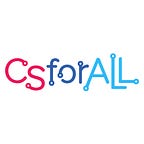#CSforALL — the Nexus of Identity & Power
By Stephanie Rodriguez, PhD of Afterschool Alliance
Intersectionality. Anyone who has been awake, listening, and watching public discourse the last few years has probably heard this word thrown around, almost daily. Many important and timely movements — #SayHerName, The Women’s March, #MeToo — are acknowledging and attempting rectify what Kimberlé Crenshaw, who first coined the term in the late 80’s, has called “intersectional failures from yesterday.” However, as we watch these movements grow, and applaud the cultural and ethnic diversity of these coalitions, let us not forget that the value of intersectionality is not simply in counting the multiplicity of identities embodied by a person, but understanding and acknowledging the relationship of those intersecting identities to power.
What does intersectionality have to do with a successful CSforAll movement? Everything.
The CS equity movement is framed as an attempt to close the gender gap in tech and ensure more “women and underrepresented minorities” have a seat at the innovation table. This is about power: economic power, as more and more lucrative jobs are tech-enabled; and social power, as every facet of our daily lives become rooted in the consumption and use of technology. The goal of CSforAll is to see a reality where all people, all combinations of identities, are contributing to the creation of technology and have access to the power that goes with that creation.
If by “women,” we mean women of color, too, and if by “underrepresented minorities”, we mean those historically marginalized and disempowered regardless of gender identity, then an intersectional lens is required, and the lessons from that lens must fuel our action. Too often, efforts to broaden the participation of women and girls are skewed, unintentionally or otherwise, toward (wealthy) white females, and efforts to combat race-based underrepresentation are focused on men. Who does this leave out?
Computer science classes in schools that are 99% Black and Hispanic often have classroom demographics that are 90% white and Asian.
There is an assumption that a well-placed, well-intentioned intervention is enough to expand access and fuel cultural change, without addressing the ingrained systems of oppression that have created the exclusionary space. Here is the reality: Computer science classes in schools that are 99% Black and Hispanic often have classroom demographics that are 90% white and Asian. In 2015, about 20% of CS Ph.D.s were awarded to women — abysmal, right? But we can dig deeper. A closer, intersectional look reveals that nearly 60% of those awards went to nonresident females, 23% to white women, 9% to Asian women, 2.5% to Black women, and about 0.5% to Hispanic or Native Hawaiian/Pacific Islander, respectively. 0% of Ph.D.s were awarded to American Indian/Alaskan Native women that year.
This trend persists across the grade span, degree levels, and in the academic and industrial CS professions. Clearly, if we want to see more women of color pursue and earn these credentials and reshape the culture of technology, an intentional approach focused on supporting these specific groups of women at the systemic level is required.
Intersectional approaches are necessary to realize CSforAll. My suggestion: disaggregate your data, understand for whom and in what contexts an intervention is effective (or not), listen to the communities you serve, and realize that the goal is to empower the disempowered.
Stephanie Rodriguez, PhD, is Director of STEM Policy at Afterschool Alliance, a CSforALL member organization. She is responsible for creating and advancing federal, state, and local opportunities and policies to expand resources and activities that provide students with access to a rich STEM curriculum in afterschool programs. Stephanie brings years of experience in STEM education research and outreach to a wide variety of audiences in this role. Before joining the Afterschool Alliance, Stephanie served as an AAAS Science & Technology Policy Fellow at the National Science Foundation where she worked on efforts to broaden participation in computer science and other STEM fields. Prior to her fellowship, Stephanie served as Director of the Young Scientist Program, a 26 year-old outreach program that engages St. Louis public school teachers and students in hands-on STEM experiences. Stephanie completed her PhD in immunology at Washington University in St. Louis, where she studied the T-cell development process and devised innovative strategies to observe this phenomenon in live animals, in real time, using advanced microscopy techniques. She received her B.S in biological sciences from Stanford University.
